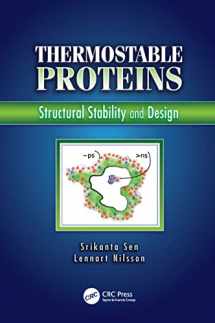
Thermostable Proteins: Structural Stability and Design
ISBN-13:
9781138114821
ISBN-10:
1138114820
Edition:
1
Author:
Lennart Nilsson, Srikanta Sen
Publication date:
2017
Publisher:
CRC Press
Format:
Paperback
188 pages
FREE US shipping
Book details
ISBN-13:
9781138114821
ISBN-10:
1138114820
Edition:
1
Author:
Lennart Nilsson, Srikanta Sen
Publication date:
2017
Publisher:
CRC Press
Format:
Paperback
188 pages
Summary
Thermostable Proteins: Structural Stability and Design (ISBN-13: 9781138114821 and ISBN-10: 1138114820), written by authors
Lennart Nilsson, Srikanta Sen, was published by CRC Press in 2017.
With an overall rating of 4.2 stars, it's a notable title among other
books. You can easily purchase or rent Thermostable Proteins: Structural Stability and Design (Paperback) from BooksRun,
along with many other new and used
books
and textbooks.
And, if you're looking to sell your copy, our current buyback offer is $0.5.
Description
Thermostable Proteins: Structural Stability and Design provides a comprehensive, updated account of the physical basis of enhanced stability of thermophilic proteins and the design of tailor-made thermostable proteins, paving the way for their possible industrial applications. This book is devoted to understanding the survival mechanisms of "thermophilic life forms" at the molecular level with an emphasis on design strategies. The review chapters presented in Thermostable Proteins span a wide range of protein thermostability research. Basic structural, thermodynamic, and kinetic principles are explained and molecular strategies for the adaptation to high temperatures are delineated. In addition, this book covers: Computing and simulation methods in current and future thermostability research, especially in nonempirical situations How rigidity theory is used to improve the thermal adaptation of mesophiles Subtilisin-like serine proteases and their significant engineering applications The state of knowledge concerning structure–function relations and the origins of their structural stability Computational and experimental approaches for the design of proteins with increased thermal stability based on sequences or three-dimensional structures Understanding the molecular basis of how thermostable and hyperthermostable proteins gain and maintain their stability and biological function at high temperatures remains an important scientific challenge. A more detailed knowledge of protein stability not only deepens our understanding of protein structure but also helps in obtaining insights into processes that drive protein activities―folding, unfolding, and misfolding―essential to biological function.


We would LOVE it if you could help us and other readers by reviewing the book
Book review

Congratulations! We have received your book review.
{user}
{createdAt}
by {truncated_author}


